By Thu Hằng
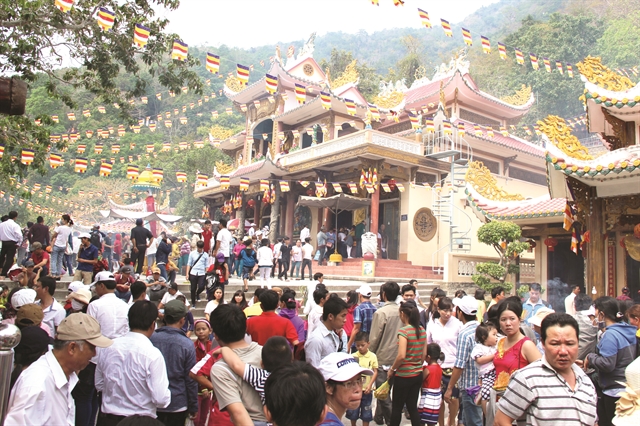
The 300-year-old Bà (Lady) Temple (Linh Sơn Tiên Thạch Tự), built on Bà Đen Mountain, is a sacred place for Buddhists and attracts thousands of pilgrims who pray for peace, good fortune and prosperity. - VNA/VNS Photo Lê Đức Hoảnh
Noted for the sacred Bà Đen (Black Lady) Mountain and the headquarters of the Cao Đài religion, the southeastern province of Tây Ninh has transformed from a once-fierce battleground to an alluring tourist destination awaiting pilgrims and lovers of culture and nature.
A visit to Tây Ninh, located about 100km from HCM City and 170km from Phnom Penh, Cambodia, can be easily arranged by car, bus or motobike from neighbouring localities in the southeast region.
Lying in the middle of a fertile plain, Bà Đen Mountain covered with white clouds nearly year-round is one of three mountains in the Bà Đen Mountain Relic and Cultural complex: Bà Đen Mountain at a height of 986 metres above sea level, Phụng (Phoenix) Mountain and Heo (Pig) Mountain.
The 300-year-old Bà (Lady) Temple was built on the mountainside of Bà Đen Mountain, a sacred place for Buddhists. It attracts thousands of pilgrims headed for the temple to pray for peace, good fortune and prosperity.
The busiest times of the year for pilgrimages are the first lunar month during the Bà Đen Mountain Spring Festival and the 5th to 6th day of the fifth lunar month for Black Lady's birthday anniversary.
Hòa Đồng Temple, Hang Temple, Quan Âm Temple and Trung Temple with distinct architectural styles are scattered around Bà Đen's mountainside.
Trần Thị Tú Uyên, a young woman from HCM City, says that Bà Đen Mountain is an ideal spot for a weekend escape from busy city life.
“Sitting on the top of the mountain is really a fantastic experience. There’s a great view of the fertile plain and lakes below,” Uyên says. "It is a perfect place to take pictures with spectacular 360-degree views."
Taking a trip on the cable cars to the mountaintop to catch a stunning panoramic view is a great relief from the hotter weather of the city. It takes only six minutes to the Bà Temple and eight minutes to get to the Bà Đen mountaintop by cable car. Visitors can also trek on the footpath to the top of the mountain, which takes at least two hours.
Cao Đài Tây Ninh Holy See
Also not to be missed on a visit to Tây Ninh is the Cao Đài Tây Ninh Holy See, 5km away from Tây Ninh Town, the headquarters of the Cao Đài religion known as Caodaism.
The giant, bright temple which was built in 1931 and officially inaugurated in 1955 is the most important shrine for the religion’s four million followers.
The Caodai Archbishop of Tây Ninh Holy See, Ngọc Hồng Thanh, said the Holy See, with its western and eastern architectural style, has become a popular tourist attraction in Tây Ninh, drawing 100-200 foreign tourists a day.
It is worth visiting during prayer sessions. The session at noon is most popular with tour groups, according to a local tour guide.
Đại Lễ Đức Chí Tôn, the festival to commemorate God the Father on the 9th day of the first lunar month, and Hội Yến Diêu Trì, the festival to commemorate the Holy Goddess Mother on the 15th day of the lunar August, are the two largest festivals of Caodaism.
The festivals feature a variety of artistic performances such as the four sacred animal (dragon, kylin, tortoise, phoenix) dances at parades, performances of traditional musical instruments, and Cao Đài vegetarian dishes processed and decorated in a unique way.
The religious events attract hundreds of thousands of pilgrims and tourists at home and abroad every year.
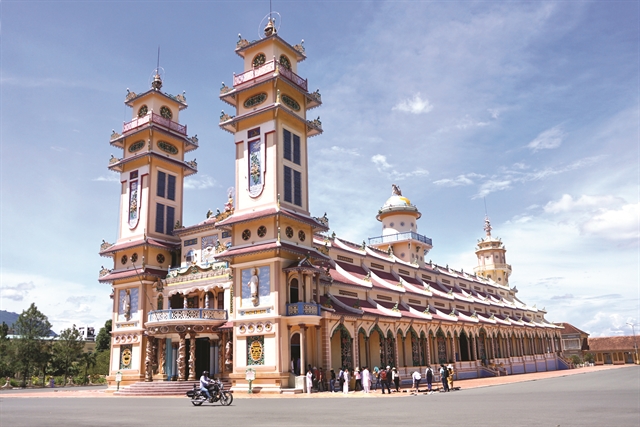
The Cao Đài Tây Ninh Holy See, the headquarters of Cao Đài religion or Caodaism, is one of the most popular tourist attractions in Tây Ninh, drawing 100-200 foreign tourists a day. — VNS Photo Thu Hằng
Historical relics
During the anti-American war, the Central Party Committee Office for South Việt Nam, or the Central Office for South Viêt Nam, was moved to the northern Tây Ninh resistance base. The location is now recognised a special national historical relic.
The relic, 60km away from Tây Ninh Town, in the pristine forest is a reminder of days of hardship, incredible bravery and an unbeatable spirit of liberation fighters.
The Central Office for South Việt Nam was the "nerve centre" that led the South Việt Nam revolution from the first days of the Vietnamese people's resistance war against foreign invasion.
Lê Trương Hoàng Nam from Vietravel says the relic is included on tours that offer an in-depth look into some of Việt Nam’s most interesting historical sites in the south.
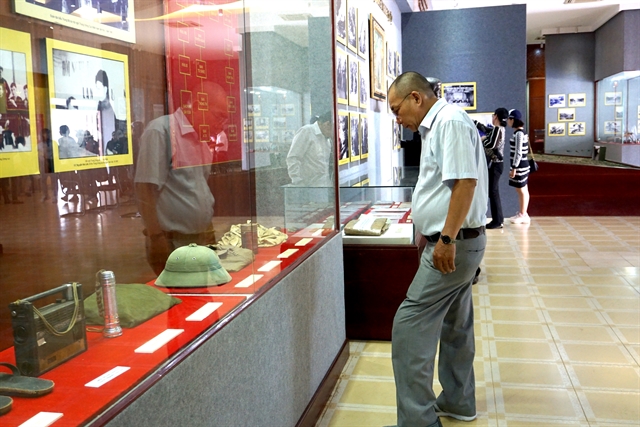
Visitors at an exhibition hall at the Central Office for South Việt Nam Base, a special national relic. — VNS Photo Thu Hằng
Regional linkages
The province shares a 240km border with Cambodia, with two international border checkpoints -- Mộc Bài and Xa Mát -- where international tourists can enter.
Nguyễn Hồng Thanh, director of the province’s Department of Culture, Sports and Tourism, says the province offers an abundance of activities, including spiritual tours, wildlife tours at the Lò Gò-Xa Mát National Park, eco-tours at Mã Thiên Lãnh Valley and sites along Vàm Cỏ Đông and Sài Gòn rivers, and tours to historical relics.
The diverse cuisine in Tây Ninh is also a delight, with specialities such as bánh tráng phơi sương Trảng Bàng (Trảng Bàng dew-wetted rice paper), Tây Ninh veal, shrimp chilli salt, and sweet fragrant Bà Đen custard-apples.
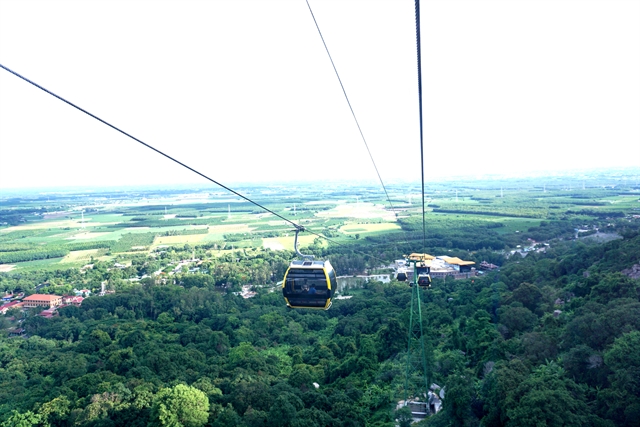
Visitors get to the Bà Đen mountaintop by cable car. - VNS Photo Thu Hằng
In the province's Trảng Bàng District, the traditional craft of making rice paper has been recognised as a National Intangible Cultural Heritage.
To appeal to more visitors, Tây Ninh will continue to diversify its tourism products and services and strengthen linkages in the southeast region comprising HCM City and Tây Ninh, Đồng Nai, Bình Dương, Bà Rịa-Vũng Tàu and Bình Phước provinces. — VNS
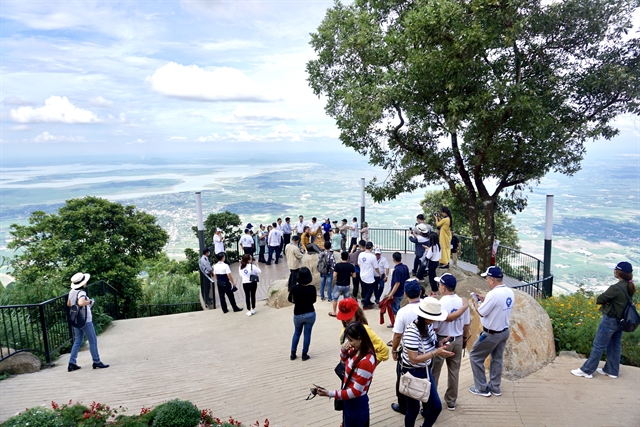
Visitors take photos at the peak of Bà Đen Mountain. — VNS Photo Thu Hằng
OVietnam